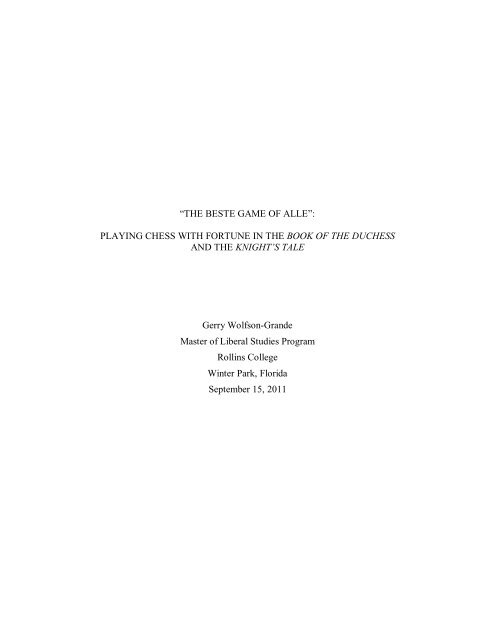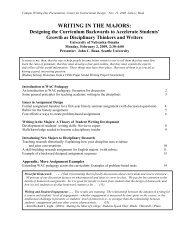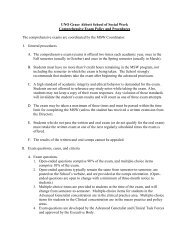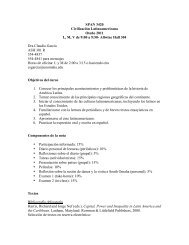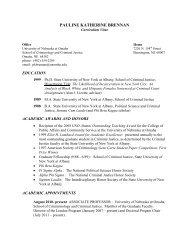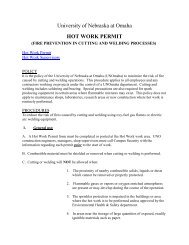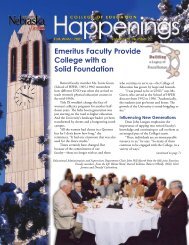âTHE BESTE GAME OF ALLEâ: PLAYING CHESS WITH FORTUNE ...
âTHE BESTE GAME OF ALLEâ: PLAYING CHESS WITH FORTUNE ...
âTHE BESTE GAME OF ALLEâ: PLAYING CHESS WITH FORTUNE ...
Create successful ePaper yourself
Turn your PDF publications into a flip-book with our unique Google optimized e-Paper software.
“THE <strong>BESTE</strong> <strong>GAME</strong> <strong>OF</strong> ALLE”:<br />
<strong>PLAYING</strong> <strong>CHESS</strong> <strong>WITH</strong> <strong>FORTUNE</strong> IN THE BOOK <strong>OF</strong> THE DU<strong>CHESS</strong><br />
AND THE KNIGHT’S TALE<br />
Gerry Wolfson-Grande<br />
Master of Liberal Studies Program<br />
Rollins College<br />
Winter Park, Florida<br />
September 15, 2011
Gerry Wolfson-Grande 1<br />
I. Introduction<br />
While the Knight’s Tale does not incorporate a direct chess metaphor, an analogy may be<br />
made between its central themes and the game of chess, particularly when it is read in connection<br />
with the Book of the Duchess. Both poems are based on love pursued and won, only to be lost<br />
arbitrarily and capriciously despite the ordered environment in which they take place. In the<br />
Book of the Duchess, this process is compared specifically to a chess game between two<br />
individuals, the grieving Man in Black and the personification of fortune. The Knight’s Tale<br />
increases the cast of characters, the playing field, and even the number of levels of the game,<br />
wherein Fortune is not portrayed so much as a specific character but as an impersonal force<br />
which influences the actions of gods and humans, and the struggle to impose order on disorder<br />
plays out in both spheres as well. While there is no direct evidence that Chaucer may have<br />
entertained such a premise, in effect, the Knight’s Tale can be viewed as a multi-dimensional<br />
chess game played by primary and ancillary opponents on a variety of levels from the individual<br />
and mundane to the cosmic.<br />
II.<br />
Chaucer and Chess<br />
According to historian David Shenk, the game of chess is “a miniature reflection of<br />
society” which has been used as a metaphor encompassing “everything from romantic love to<br />
economics” for the entirety of its history. 1 In the Middle Ages, it was a part of the nobility’s<br />
education (male and female), as well as an often illicit amusement among the religious orders,<br />
despite frequent bans due to its association with gambling. By Chaucer’s day, several literary<br />
works on chess had been published. He would have been familiar with at least two of them,<br />
Jacobus de Cessolis’ Liber de moribus hominum et officiis nobelium (“Book of the customs of<br />
men and the duties of nobles”), or The Book of Chesse, and Jeu de Echecs by Jehan Vignay. 2
Gerry Wolfson-Grande 2<br />
There has been some debate among chess scholars as to the first, as Caxton did not publish the<br />
first English version until the mid-fifteenth century; but, as Guillemette Bolens and Paul<br />
Beekman Taylor point out, numerous translations did exist in French, Latin, and German prior to<br />
that point, and Chaucer likely would have read it in either French or Latin. 3 Even though<br />
Chaucer made few references to the game in his own work other than the Black Knight’s<br />
soliloquy in Book of the Duchess, historian Jenny Adams concurs with Bolens, stating that<br />
Chaucer’s access to the poems and romances of the period, rich in “chess lore and myth,” would<br />
have given him more than enough familiarity with the game and its conventions, literary and<br />
otherwise. 4<br />
Furthermore, according to medievalist Mark Taylor, Chaucer’s reference to<br />
“jeopardyes” 5 is based on specific knowledge of written collections of chess problems, also<br />
known as jeopardies or partita, two of which surviving today have been dated to the late<br />
thirteenth or early fourteenth century in England. 6<br />
Interestingly, medieval chess games frequently played out in violence once the issue of<br />
checkmate, or pending checkmate, arose, the implication being that losing or resigning did not<br />
rest easily on the medieval mind. Many of the romances refer to games ending in duels, or even<br />
outright brawls, rather than in checkmates, complete with pieces being thrown and boards being<br />
used either as weapons or shields. 7 In this light, even a tournament is not outside the realm of<br />
possibility!<br />
III.<br />
Fortune and Her Wheel<br />
The influence of fortune is at the heart of both poems. In the Book of the Duchess,<br />
Chaucer links it directly to the chess metaphor, presenting “fals Fortune” as the Black Knight’s<br />
opponent. 8 As was common in both chess practice and literature in the Middle Ages, 9 the Black<br />
Knight has chosen to gamble on this match, but the stakes are much more substantial than a
Gerry Wolfson-Grande 3<br />
typical wager, for he is playing with the life of his lady. 10 It is also a pointless bet; at a crucial<br />
point in the game, Fortune captures the Black Knight’s fers, or queen, representing his lady, and<br />
polishes him off with an errant pawn one move later. 11 Within a few moves, Fortune displays just<br />
how quickly her wheel can fling a hapless mortal from its top to the ground. Taylor points out<br />
that the Black Knight’s ignorance of Fortune’s dual nature allowed him to delude himself as to<br />
“what to expect at the height of his happiness.” 12 But the Knight’s resentment of Fortune’s whim<br />
is temporary; he eventually does acknowledge, however ruefully, that he “wolde have drawe the<br />
same draughte” regardless of any opportunity for foreknowledge of Fortune’s capricious<br />
nature. 13 His grief, then, is for the actual physical loss of his love rather than constituting an<br />
embittered outcry towards his opponent, whose influence over the lives of men he understands<br />
and accepts even while wishing she had treated him differently.<br />
The concept of Fortune as an impartial and arbitrary entity was a continuing focus during<br />
the Middle Ages. Howard Patch delineates three primary viewpoints: the romantic, “content to<br />
leave things to chance, with or without personification”; the rationalist, who, in the Aristotlean-<br />
Aquinian tradition, denied Fortune’s existence; and those in the middle, who “held to a belief in<br />
chance subordinate to reason, a kind of personification of Aristotle’s causa per accidents.” 14 He<br />
notes that, in a contest between the philosopher and the poet to further define the third category,<br />
the poet would succeed in refuting the “hardheaded philosopher” by “replying that even the<br />
philosopher must admit the existence of apparent chance.” 15 Patch also contends that Fortune’s<br />
increased literary visibility during a time when poets freely borrowed from their predecessors<br />
and each other, as well as the highly unstable political and social environment, increasing a sense<br />
that “circumstances really turn on the wheel of the fickle goddess,” also contributed to bringing<br />
Fortune’s role, now super-sized, back into the popular spotlight. 16
Gerry Wolfson-Grande 4<br />
This is the Fortune of the Knight’s Tale, perhaps more force than persona, but Chaucer<br />
deliberately makes her powerful enough to affect the orderly progression of life and the fates of<br />
the tale’s characters, diverging from Boccaccio’s example. In the Teseida delle Nozze d’Emilia,<br />
Fortune is frequently characterized as “angry,” 17 “wretched,” 18 and “cruel,” 19 or reviled with<br />
specific reference to the individual complaint. Only at the beginning of Book VI does Boccaccio<br />
acknowledge her random whimsy:<br />
Fortune, that lofty governess of the world who changes one thing into another<br />
over and over with her inconstant movements . . . just as it suits her to do and how<br />
and when it suits her. 20<br />
Chaucer views her with more consistent objectivity. 21 Palamon and Arcite are ruled by Fortune<br />
in all of her aspects, although Arcite acknowledges it far more frequently, beginning with his<br />
observation while both share the same prison that Fortune gave them “this adversitee.” 22 Having<br />
acknowledged Fortune’s influence, Arcite is even inclined to fling himself toward what she<br />
might hold for him regardless of any potential cost, proclaiming, “And everich of us take his<br />
aventure,” and clings to this belief despite being exiled from Athens (and Emelye). 23 While<br />
Palamon acknowledges the power of Fortune, he does not understand the connection between it<br />
and any actions he might take. 24 This dynamic is emphasized in the relationships between the<br />
two and their respective patron gods, Mars and Venus, who “act along the most simple lines of<br />
policy as if they were pieces in a game of chess,” 25 as well as the influence of Fortune on all<br />
four. Alexandra Cook has observed that the lovers perceive a connection “between the act of<br />
surrendering oneself to the mercy of capricious, whimsical gods and surrendering oneself to the<br />
experience of romantic love.” 26<br />
Nor is Fortune content with merely ruling the affairs of Palamon, Arcite, and the object<br />
of their mutual desire, Emelye. Even the social and political structure created by Theseus is
Gerry Wolfson-Grande 5<br />
subjected to Fortune’s regard, and the case could be made that it is the true target of Fortune’s<br />
actions. The Knight’s Tale contains a distinct progression of actions and events, much as the<br />
progression of a chess game: move, encounter/attack, immediate result, and ramifications<br />
reaching beyond the initial battle to affect the stability and fortunes of both sides. The element of<br />
chance represented by wagering in the medieval game, including dice play that frequently<br />
involved variations to moves dictated by the roll of the dice, 27 equates to the role of Fortune in<br />
the tale. Even when a particular encounter appears to be moving toward a specific and perhaps<br />
obvious conclusion, Fortune’s hand tosses the dice and introduces an unexpected element to<br />
change the direction of the game.<br />
Merle Fifield has analyzed the patterns of specific incidents within the Knight’s Tale,<br />
contending that they “follow a simple cause-to-result climactic order resolved by the intervention<br />
of Fortune or her agent,” with the additional element of celestial disorder “resolved by the<br />
intervention of Fortune in the character of Saturn” during the theater section:<br />
The opening section demonstrates the irresistible force of Fortune; the duel<br />
illustrates the failure of individual action; the description of the theater proves the<br />
failure of all earthly order; the tournament illustrates the failure of corporate<br />
action; and the sermon offers the only solution to survival in a world governed by<br />
eternal change against which both man and society are powerless. 28<br />
This pattern is not dissimilar to a chess match: opening exploratory moves; interaction between<br />
questing lesser pieces aimed at winnowing down the opponent’s forces; extended battling by<br />
lesser and key pieces; and eventual mate or resignation acknowledging inescapable helplessness.<br />
Even though, like Arcite, the player may attempt to anticipate his opponent’s actions, accepting<br />
their likelihood and that of his own contribution to the direction of play, the element of the<br />
unknown, or chance, can deliver the unexpected at any time and send the game careening in a<br />
different direction. Fifield points out that the “consistent original impetus of all action is force—
Gerry Wolfson-Grande 6<br />
Theseus’ force and Fortune’s force—neither of which can be directed or reversed by Palamon<br />
and Arcite.” 29 One goes off into exile, the other remains in prison, and the Knight asks the<br />
company which “hath the worse.” 30 The hand of Fortune lies equally heavily on them both.<br />
Fortune returns with equally arbitrary impartiality in Part II of the Knight’s Tale. Through<br />
somewhat vague circumstances involving assistance by an unidentified “friend,” but which the<br />
Knight imputes to “aventure or destynee -- / As, whan a thing is shapen, it shal be,” Palamon<br />
slips his leash and escapes. 31 Fortune then turns her attention to Arcite, who coincidentally<br />
manages to blunder into the exact same shrubbery where Palamon lurks “as by aventure.” 32<br />
Fifield contends that the degree to which their enmity is renewed is the result of their mutual<br />
realization that, rather than each being free to pursue Emelye’s hand without interference, they<br />
have both been duped by Fortune once again, and that this is the cause of the animal viciousness<br />
with which they fight. 33 Once again, however, Fortune interferes, this time by utilizing the<br />
would-be agent of order, Theseus, who stops the duel, separates the players, and imposes his<br />
own interpretation of Fortune’s will upon them: “That ech of yow shal have his destynee / As<br />
hym is shape, and herkneth in what wyse; / Lo heere youre ende of that I shal devyse.” 34<br />
The construction of the lists and associated temples in Part III is representative of the<br />
continued order instituted by Theseus, the wheel of Fortune notwithstanding. Chaucer’s lengthy<br />
descriptive passages accentuate this aspect by their comprehensiveness, to the point where, as<br />
Muscatine remarks, the descriptions seem to “consume the full fifty weeks that Theseus allows<br />
for it.” 35 The ponderous progression is also reminiscent of the mid-game in chess, as lengthy<br />
combinations of moves are made in an attempt to establish a defensive bulwark from which to<br />
launch one’s own offensives. The setting is relatively secure as the three supplicants visit the<br />
temples of their respective patron gods (or goddesses). Even the varying degrees of vague
Gerry Wolfson-Grande 7<br />
assurance rendered are not overly disturbing: Venus shakes and makes an indeterminate<br />
“signe”; 36 the metal accoutrements and doors on Mars’ temple ring and clatter, and Arcite<br />
believes he hears a voice saying “Victorie.” 37 Ironically, the ever-present Wheel does not cast as<br />
large a shadow for the young men during their supplications, despite their frequent references to<br />
its owner up to this point, as for Emelye. Only Diana is willing to concede the potential influence<br />
of Fortune, telling Emelye that she cannot say which rival will claim the reluctant maiden. 38<br />
With the focus on the two young men and their patrons, this reminder of Fortune’s role<br />
may not necessarily seem significant. Chaucer’s descriptions of the temples, however, should<br />
give it more weight. His inclusion of a blind Cupid “as it is often seene” in Venus’ temple 39 as<br />
well as geomantic figures Puella and Rubeus in Mars’ entourage 40 point more specifically to<br />
Fortune’s influence. Then there is Diana’s temple, where the goddess, standing on a “wexynge”<br />
moon that “sholde wanye soone,” 41 is surrounded by representations of unfortunates in Greek<br />
mythology who underwent transformations of some sort through her agency, 42 and most of<br />
whom were her victims. 43 When the mutability aspect of the moon, personified in Diana, is<br />
added to these representations, the looming persona of Fortune is no longer avoidable. 44<br />
Once Fortune enlists the participation of Saturn, however, the course of the tournament is<br />
firmly under her control. This is a major deviation from the Teseida; Boccaccio does not release<br />
Saturn from his Tartarean pit, but assigns the task of retrieving the hellish Furies to Venus in<br />
accordance with the agreement she has made with Mars as to the resolution of the battle. 45<br />
Chaucer, however, frees the Saturn/Cronus figure and puts him to work. In fact, he first appears<br />
in Arcite’s initial mention of Fortune and her influence upon the unfortunate cousins’ paths in<br />
life:<br />
Fortune hath yeven us this adversitee.<br />
Som wikke aspect or disposicioun
Gerry Wolfson-Grande 8<br />
Of Saturne, by som constellacioun,<br />
Hath yeven us this, although we hadde it sworn;<br />
So stood the hevene whan that we were born. 46<br />
One school of criticism sees Saturn as the “evil genius” of the Knight’s Tale, a<br />
malevolent power superseding even Jupiter. 47 Yet the Knight’s introduction of Saturn does not<br />
appear to ascribe absolute independence to Saturn’s force; at most, it implies equality with<br />
Fortune. However, Fortune receives primary billing where Arcite (who comments frequently on<br />
Fortune and her actions) is concerned, and it is only a heavenly “aspect or disposicioun” of<br />
Saturn, rather than the entire personality, which he mentions secondarily. Additionally, Saturn<br />
himself is surprisingly reticent about the extent of his powers. He begins by claiming that his<br />
“cours, that hath so wyde for to turne, / Hath moore power than woot any man.” 48 Yet his selfproclaimed<br />
orbit of influence is limited; although he governs such matters as punishment of<br />
criminals, pestilence, and other dark and fatal areas, he then points out that “I do vengeance and<br />
pleyn correccioun, / Whil I dwelle in the signe of the leoun.” 49<br />
This last statement presents an interesting question as well. In The Age of Saturn:<br />
literature and history in the Canterbury Tales, authors Brown and Butcher examine several of<br />
the tales, including the Knight’s Tale, in the context of historical events during the latter part of<br />
the fourteenth century. 50 Saturn’s journey from one zodiacal sign to another takes about twentyfive<br />
months, requiring approximately twenty-nine years (including retrograde movement) to<br />
complete the entire tour; it would have been in Leo between July 1387 and August 1389. 51 If one<br />
accepts Brown and Butcher’s premise, Chaucer might very well have taken this factor into<br />
consideration. However, according to astrologer Stephanie Johnson, Saturn’s dominant signs, its<br />
“Essential Dignities,” are Capricorn and Aquarius; Leo, as a sign in direct opposition and thus an<br />
“Essential Debility,” would have actually decreased Saturn’s influence. 52 Considering the
Gerry Wolfson-Grande 9<br />
various astronomical and astrological references in the Knight’s Tale alone, it seems that<br />
Chaucer would have been aware of Saturn’s ascribed abilities in the different signs. While Saturn<br />
would still evince his malefic aspect during his journey through Leo, he would not have been<br />
considered to possess any significant degree of clout at that time. Chaucer could have easily<br />
placed him in Aquarius or, better yet, Capricorn, the stronger of Saturn’s two dominant signs,<br />
thus giving him the necessary standing.<br />
Chaucer deliberately evokes Saturn’s planetary aspect rather than giving him omnipotent<br />
maleficent powers, referring to him as “pale saturnus the colde,” with orbit “so wyde for to<br />
turne.” 53 According to David Gaylord, Saturn may have more power than any man knows, 54 but<br />
he is only “an astrological adjunct to Boethian themes of providence, destiny, and free will.” 55<br />
Dorothy Bethurum Loomis makes a similar observation, noting that Chaucer’s use of Saturn<br />
represents the Neoplatonist view that “all [planets] express the will of Providence.” 56 Perhaps<br />
even more significant is the fact that, as Gaylord points out, other than Arcite’s initial reference<br />
to Fortune and Saturn, 57 none of the key human players even acknowledge Saturn’s existence in<br />
general or view him as a maker of destiny, much less as one on a par with or superior to<br />
Fortune. 58<br />
Given the overwhelming influence of Fortune through the first three parts, then, as well<br />
as the failure of any character to echo or even refer to Saturn’s declarations, not to mention the<br />
purely arbitrary choice of mechanism employed to fling Arcite from the top to the bottom of<br />
Fortune’s wheel, embodied in the Fury summarily summoned by Pluto at the snap of Saturn’s<br />
fingers, it is difficult to credit that Fortune has conceded her control of the game to a sole god,<br />
however inimical, who is technically subservient to another god. An analogy could be drawn<br />
between the Fury of the Knight’s Tale and the “poune erraunt” of the Book of the Duchess; 59
Gerry Wolfson-Grande 10<br />
having established her supremacy on both playing fields by capturing the Black Knight’s queen<br />
on the one and successfully inciting Venus and Saturn to conspire to wreak havoc on the other,<br />
Fortune can employ lesser means to finish off her chosen victims.<br />
It is far more conceivable, therefore, that Saturn is acting as Fortune’s agent. Fifield<br />
states that men and gods alike are ruled by Fortune; “a meaningless human order is dedicated to<br />
a disordered hierarchy of minor controlling forces who, in turn, are subject to Fortune grinding<br />
all beneath Her wheel. . .the intervention of Saturn [in achieving Arcite’s downfall], as Fortune<br />
and not what men think Fortune is, makes the expected reversal which more completely<br />
separates the lovers than before.” 60 Even Brown and Butcher concede that Egeus, Saturn’s<br />
representative, possesses “mind-numbing ‘wisdom’. . .based on the life-long observation of<br />
change. . .The ‘up and down’ process is the movement of Fortune’s wheel.” 61<br />
Chaucer leaves no room for doubt in the Knight’s Tale as to the role of Fortune and the<br />
effect of her wheel, deliberately choosing to intermix the latter concept with the Knight’s<br />
“concern with the instability of human ‘wele’ astride the ever-turning wheel of Fortune.” 62<br />
Saturn’s comment to Venus concerning his wide-turning course 63 is further evidence of<br />
Chaucer’s play on words, emphasizing the fact that neither gods nor humanity have any control<br />
over either the wheel of Fortune or the course of her agents, the planet deities. 64 As Kathleen<br />
Blake notes: “The deciding force is actually Fortune, which pervades the tale. At every step of<br />
the way we hear of Fortune, Fortune’s wheel, Fortune’s dice, Fate, ‘Nature,’ ‘aventure,’ ‘cas,’<br />
‘nedes coste,’ providence, Boethian ‘destinee,’ the stars, the gods.” 65 Clearly, it is Fortune who is<br />
in charge here, of men and gods alike. 66
Gerry Wolfson-Grande 11<br />
IV.<br />
Order and Disorder<br />
Chaucer explores the antagonistic interaction between order and disorder, or logic and<br />
chaos, to a small extent in the Book of the Duchess before adopting it as a primary theme in the<br />
Knight’s Tale. The narrator, observing a hunt passing through the woods, inquires of one of the<br />
dog handlers who hunts there, and is told, “the emperor Octovien.” 67 James Winny interprets this<br />
reference to an unseen authority and the potential disruption stirred up by the hunt as an<br />
indication that Chaucer was feeling his way towards “expression of this emerging interest” in the<br />
“contest between authority and disorder.” 68<br />
While Winny’s conjecture is relatively minor, the significance of the relationship<br />
between order and disorder is more substantial in the Knight’s Tale. Along with Fortune, it<br />
defines the relationship and rivalry between Palamon and Arcite, the actions of the various gods<br />
who become involved, and Theseus’ efforts to arbitrate suitable outcomes; the effect of Fortune’s<br />
chaotic influence on each exacerbates all three areas. Robert Blanch and Julian Wasserman relate<br />
the separate choices of traditionally linked colors made by the two heroes (red for Arcite, white<br />
for Palamon) to a “dualism that is of their own making rather than of ontological<br />
fact . . . . separating those things which are traditionally intertwined and are hence disrupting<br />
what might be viewed as a natural unity.” 69 It is up to Theseus to combine the two colors, and<br />
presumably repair this dualism, as the “practitioner of moderation” and “arbiter and. . .restorer of<br />
balance and order.” Fifield suggests that it is in fact the “trial and error method of meditation,<br />
action, and defeat” employed by Palamon and Arcite that allows Theseus to evolve from his<br />
early role as conqueror to that of problem-solver, developing “a progression of logical<br />
deductions, each of which proceeds from his earlier deduction and all of which appear in his<br />
sermon as necessary steps in achieving his conclusion.” 70
Gerry Wolfson-Grande 12<br />
According to Charles Muscatine, the Knight’s Tale is a “poetic pageant” in which the<br />
“general tenor of noble life. . .invokes order” with a “constant awareness of a formidably<br />
antagonistic element—chaos, disorder—which in life is an ever-threatening possibility.” 71 This<br />
order is supported by symmetry in the various groupings of characters, whether they are humans<br />
or gods, and even the descriptions of structures contain a balance. 72 As king and proponent of the<br />
principles designated by the Prime Mover, Theseus is the primary representative of order in the<br />
poem. 73 In fact, Muscatine contends, “When the earthly designs suddenly crumble, true nobility<br />
is faith in the ultimate order of all things. Saturn, disorder, nothing more or less, is the agent of<br />
Arcite’s death, and Theseus, noble in the highest sense, interprets it in the deepest perspective.” 74<br />
Not all Chaucer scholars agree with Muscatine in his glorification of Theseus as prime<br />
standard-bearer for Order. Joseph Westlund believes that Theseus is woefully inadequate to the<br />
task, and that the Knight’s true focus is the “subversion of noble efforts to bring order out of<br />
disorder.” 75 He does not so much assign responsibility for this subversion to Fortune as to the<br />
entire pantheon of gods, although he assigns the role of “misfortune” to Saturn; more<br />
importantly, Westlund considers the presence of the gods and their attendant disruptive aspects<br />
to imply that the lives of mortals have little meaning in this context, particularly absent any<br />
constructive effort by Theseus to resolve the situation in favor of order. 76 Blake contends that<br />
Theseus’ “ordering will is not a medium through which chaos is subdued and divine providence<br />
put into effect on earth in the form of civil law and the civilized life.” 77 E.D. Blodgett takes<br />
opposition to Muscatine’s premise a step further: “Theseus provides a static order within chaos<br />
by providing prisons, temples, and elaborate tournaments. Each is a spatial and geometric<br />
response to events, and each issues, wittingly or not, in strife and finally death.” 78 This statement<br />
is particularly interesting in terms of a chess-related reading of the Knight’s Tale, as it conjures
Gerry Wolfson-Grande 13<br />
images of formations of chess pieces, with rooks (prisons), bishops (temples), and knights<br />
(tournaments), along with the inherent symmetry of the game and the concept of ordered battles<br />
between pieces.<br />
Muscatine considers Chaucer’s attitude towards disorder perhaps as being even more<br />
significant than his treatment of order, although, again, it could be said that it is the resolution<br />
toward order which enhances that significance. He describes the “subsurface insistence on<br />
disorder,” including Saturn’s speeches, to be “the poem’s crowning complexity, its most<br />
compelling claim to maturity.” 79 In that sense, as noted above, Muscatine’s conclusion that<br />
Theseus, as interpreter and problem-solver, is a vital representation of order, is reasonable. 80<br />
Others are not willing to go quite that far, preferring to cast Saturn in the role of chief<br />
agent of chaos, who may or may not be acting in accord with Fortune, or who may be acting<br />
entirely independently of any other influences. According to Robert Emmett Finnegan, Chaucer<br />
chose to add Saturn to the cast of characters borrowed from Boccaccio in order to emphasize<br />
“the problematic character of his gods, the serious nature of the division in heaven, and the<br />
ominous inability of the high god to resolve it.” 81 Blake views Saturn as an outsider, a type of<br />
universal outlaw, who creates “arbitrary and willful” solutions to problems with little or no<br />
concern for the ramifications of his actions. 82 Interestingly, she also comments that here one sees<br />
that “order may be created out of nothing, for no all-encompassing rational purpose, but out of<br />
gratuitous impulses of will.” 83 Considering that Saturn even admits that his primary motive for<br />
involving himself is to achieve peace between the squabbling Mars and Venus, 84 rather than any<br />
significant demonstration of his power, Blake may have a valid point. This does, however, then<br />
beg the question as to whether the influence of disorder, possibly operating at Fortune’s<br />
command, can actually create the opposite condition, in which case perhaps Theseus may
Gerry Wolfson-Grande 14<br />
actually be on the right track. Regardless of the nature of Saturn’s compulsions, he represents the<br />
major voice of disorder in the Knight’s Tale, thus providing an underlying support to Fortune’s<br />
directives.<br />
V. Conclusion: The “Beste Game of Alle”<br />
Having made his plan for the tournament, Theseus congratulates himself on having<br />
perpetrated the “beste game of alle” on the two knights because the object of their desire,<br />
Emelye, is totally unaware of her role in their rivalry. 85 Larry Benson, editor of the Canterbury<br />
Tales Complete, defines “game” here as “joke,” 86 although the Middle English “game” carries a<br />
variety of other meanings as well, including “[a]n athletic contest; also, a game of chess,<br />
backgammon, dice, etc.; a tournament or jousting.” 87 This incorporates the sense of a prank<br />
being played within the larger gameplay of the tournament, and within the even larger cosmic<br />
game of chess. It is not unreasonable, then, to view Chaucer’s choice of words as significant.<br />
When Fortune takes her place in the design, the scope of the “game” transforms from a<br />
minor contest into the greater conflict between chaos and order, with the element of<br />
dispassionate chance perpetually shifting the balance. Fortune’s wheel does not dictate a specific<br />
fate for the individual. Rather, it allows for the possibility of change, which may be the<br />
consequence of mischance or occur at the arbitrary instigation of some other factor, and which<br />
may have a positive or a negative result, or both. The Book of the Duchesse and the Knight’s<br />
Tale ultimately end in tragedy, capped by the actions of the errant pawn and the short-lived Fury,<br />
both representations of Fortune’s capricious nature. Whether in play with a single individual or<br />
on a larger cosmic board, Fortune wields the chess pieces, enlisting the assistance of forces of<br />
order and chaos as she sees fit.
Gerry Wolfson-Grande 15<br />
1 David Shenk, The Immortal Game: A History of Chess (New York: Random House, 2006), 15.<br />
2 Guillemette Bolens and Paul Beekman Taylor, “The Game of Chess in Chaucer's Book of the<br />
Duchess,” The Chaucer Review 32.4 (1998): 330, accessed March 6, 2011, DOI: 10.1353/<br />
cr.2001.0014.<br />
3 Ibid., 330.<br />
4 Jenny Adams, “Pawn Takes Knight's Queen: Playing with Chess in the Book of the Duchess,”<br />
The Chaucer Review 34.2 (1999): 129, accessed March 6, 2011, http://www.jstor.org/stable/<br />
25096082.<br />
5 Geoffrey Chaucer, The Boke of the Duchesse, The Online Medieval & Classical Library: line<br />
666, accessed January 24, 2011, http://omacl.org/Duchess.<br />
6 Mark N. Taylor, “Chaucer’s Knowledge of Chess,” The Chaucer Review 38.4 (2004): 303,<br />
accessed March 28, 2010, DOI: 10.1353/cr.2004.<br />
7 H. J. R. Murray, A History of Chess (Oxford: Clarendon, 1913), 739-742.<br />
8 Chaucer, The Boke of the Duchesse, lines 618-619.<br />
9 Adams, “Pawn Takes Knight's Queen,” 133.<br />
10 Chaucer, The Boke of the Duchesse, lines 668-672.<br />
11 Ibid., 654-661.<br />
12 Taylor, “Chaucer’s Knowledge of Chess,” 308.<br />
13 Chaucer, The Boke of the Duchesse, line 682.<br />
14 Howard R. Patch, “Chaucer and Lady Fortune,” The Modern Language Review 22.4 (1927):<br />
378, accessed March 6, 2011, http://www.jstor.org/stable/3714845.<br />
15 Ibid., 378.<br />
16 Ibid., 379.<br />
17 Giovanni Boccaccio, The Book of Theseus: Teseida delle Nozze d’Emilia, trans. Bernadette<br />
Marie McCoy (New York: Medieval Text Association, 1974), Book III, line 76.<br />
18 Ibid., Book IV, line 80.<br />
19 Ibid., Book IV, line 86.
Gerry Wolfson-Grande 16<br />
20 Ibid., Book VI, line 1.<br />
21 It should be noted that the word “fortune” itself appears twelve times over the course of the<br />
tale; its equivalent, “aventure,” twelve times as well, and other references such as “wheel” and<br />
“destynee” or “destinee” appear at least another seven times.<br />
22 Geoffrey Chaucer, Knight’s Tale, The Canterbury Tales Complete, ed. Larry D. Benson<br />
(Boston: Houghton, 2000), fragment 1, line 1086.<br />
23 Ibid., lines 1186, 1238.<br />
24 Merle Fifield, “The Knight's Tale: Incident, Idea, Incorporation,” The Chaucer Review 3.2<br />
(1968): 98, accessed March 8, 2011, http://www.jstor.org/stable/25093079.<br />
25 C. David Benson, “The ‘Knight's Tale’ as History,” The Chaucer Review 3.2 (Fall, 1968): 110,<br />
accessed March 10, 2011, http://www.jstor.org/stable/25093080.<br />
26 Alexandra Cook, “‘O swete harm so queynt’: Loving Pagan Antiquity in Troilus and Criseyde<br />
and in the Knight’s Tale,” English Studies 91.1 (2010): 36, accessed March 5, 2011, DOI:<br />
10.1080/00138380903355064.<br />
27 Murray, A History of Chess, 474-475.<br />
28 Fifield, “The Knight's Tale: Incident, Idea, Incorporation,” 97.<br />
29 Ibid., 99.<br />
30 Chaucer, Knight’s Tale, line 1348.<br />
31 Ibid., lines 1465-1466.<br />
32 Ibid., line 1516.<br />
33 Fifield, “The Knight's Tale: Incident, Idea, Incorporation,” 100-101.<br />
34 Chaucer, Knight’s Tale, lines 1842-1844.<br />
35 Charles Muscatine, Chaucer and the French Tradition: A Study in Style and Meaning<br />
(Berkeley: University of California Press, 1969), 177.<br />
36 Chaucer, Knight’s Tale, lines 2265-2266.<br />
37 Ibid., lines 2422-2432.<br />
38 Ibid., lines 2351-2353.<br />
39 Ibid., lines 1963-1965.
Gerry Wolfson-Grande 17<br />
40 Ibid., lines 2043-2045.<br />
41 Ibid., line 2078.<br />
42 Ibid., lines 2062-2072.<br />
43 Susan Crane, Gender and Romance in Chaucer’s Canterbury Tales, (Princeton: Princeton<br />
University Press, 1994), 182.<br />
44 Kathleen Blake, “Order and the Noble Life in Chaucer's Knight's Tale?” Modern Language<br />
Quarterly 34.1 (1973): 17, accessed March 6, 2011, DOI:10.1215/00267929-34-1-3.<br />
45 Boccaccio, Teseida delle Nozze d’Emilia, Book IX, line 4.<br />
46 Chaucer, Knight’s Tale, lines 1085-1090.<br />
47 Peter Brown and Andrew Butcher, The Age of Saturn: literature and history in the Canterbury<br />
Tales (Oxford: Blackwell, 1991), 31.<br />
48 Chaucer, Knight’s Tale, lines 2454-2455.<br />
49 Ibid., lines 2461-2462.<br />
50 Brown and Butcher, The Age of Saturn.<br />
51 CyberWorld Khaldea, Ephemeris 1300-1399, accessed April 10, 2011, http://www.khaldea.<br />
com/ephemcenter.shtml.<br />
52 Stephanie Johnson, “The Essentials of Essential Dignities,” Astrological Journal 39.6 (1997):<br />
2, accessed April 10, 2011, http://www.seeingwithstars.net/images/EssDig.pdf. For purposes of<br />
this specific paper, further exploration of this particular line of inquiry is not practical, but it is<br />
interesting.<br />
53 Chaucer, Knight’s Tale, lines 2443, 2454.<br />
54 Ibid., line 2455.<br />
55 Alan T. Gaylord, “The Role of Saturn in the Knight’s Tale,” The Chaucer Review 8 (1974):<br />
174, accessed March 10, 2011, http://www.jstor.org/stable/25093266.<br />
56 Dorothy Bethurum Loomis, “Saturn in Chaucer’s Knight’s Tale,” in Chaucer und seine Zeit:<br />
Symposium für Walter F. Schirmer, ed. Esch, Arno. Buchreihe der Anglia: Zeitschrift für<br />
englische Philologie (Tübingen: Max Niemeyer, 1968), 159.<br />
57 Chaucer, Knight’s Tale, lines 1085-1090.<br />
58 Gaylord, “The Role of Saturn in the Knight’s Tale,” 184.
Gerry Wolfson-Grande 18<br />
59 Chaucer, The Boke of the Duchesse, line 661.<br />
60 Fifield, “The Knight's Tale: Incident, Idea, Incorporation,” 103.<br />
61 Brown and Butcher, The Age of Saturn, 228; referencing Chaucer, The Knight’s Tale, lines<br />
2839-2841.<br />
62 Thomas A. Van, “Second Meanings in Chaucer's Knight's Tale,” The Chaucer Review 3.2<br />
(Fall, 1968): 72, accessed March 10, 2011, http://www.jstor.org/stable/25093076.<br />
63 Chaucer, Knight’s Tale, line 2454.<br />
64 Van, “Second Meanings in Chaucer's Knight's Tale,” 73.<br />
65 Blake, “Order and the Noble Life in Chaucer's Knight's Tale,” 11.<br />
66 Brown and Butcher’s The Age of Saturn contains an illustration captioned “Dicing, gaming<br />
and sudden death: the children of Saturn,” which displays De sphaera by Johannes de<br />
Sacrobosco. The painting shows Saturn standing in a sphere accompanied by two smaller ones<br />
containing his astrological signs, above a village scene. Gamblers are dicing on the left side of<br />
the street; sudden death (presumably of the gamblers) is happening on the right. In the middle is<br />
a walkway set out in a checkerboard pattern, and a chess game is in progress in the front center<br />
(Plate 1).<br />
67 Chaucer, The Boke of the Duchesse, lines 365-386.<br />
68 James Winny, Chaucer’s Dream-Poems (New York: Harper, 1973), 41.<br />
69 Robert J. Blanch and Julian N. Wasserman, “White and Red in the Knight’s Tale: Chaucer’s<br />
Manipulation of a Convention,” in Chaucer in the Eighties, ed. Julian N. Wasserman and Robert<br />
J. Blanch (Syracuse: Syracuse University Press, 1986), 176.<br />
70 Fifield, “The Knight's Tale: Incident, Idea, Incorporation,” 97.<br />
71 Muscatine, Chaucer and the French Tradition, 179.<br />
72 Ibid., 178.<br />
73 Ibid., 184.<br />
74 Ibid., 190.<br />
75 Joseph Westlund, “The Knight’s Tale as an Impetus for Pilgrimage,” Philological Quarterly<br />
43 (1964): 526-529.<br />
76 Ibid., 532.
Gerry Wolfson-Grande 19<br />
77 Blake, “Order and the Noble Life in Chaucer's Knight's Tale,” 15.<br />
78 E.D. Blodgett, “Chaucerian Pryvetee and the Opposition to Time.” Speculum 51.3 (1976): 487,<br />
accessed March 6, 2011, http://www.jstor.org/stable/2851709.<br />
79 Muscatine, Chaucer and the French Tradition, 189.<br />
80 Ibid., 190.<br />
81 Robert Emmett Finnegan, “The Curious Condition of Being: The City and the Grove in the<br />
Knight’s Tale,” Studies in Philology 106.3 (2009): 286, accessed March 5, 2011, DOI:<br />
10.1353/sip.0.0026.<br />
82 Blake, “Order and the Noble Life in Chaucer's Knight's Tale,” 17.<br />
83 Ibid., 17.<br />
84 Chaucer, Knight’s Tale, line 2474.<br />
85 Chaucer, Knight’s Tale, lines 1806-1808.<br />
86 Chaucer, Knight’s Tale, note to line 1806.<br />
87 Middle English Dictionary. University of Michigan, 2001, accessed March 14, 2011,<br />
http://quod.lib.umich.edu/cgi/m/mec/med-idx?size=First+100&type=headword&q1=game&<br />
rgxp=constrained
Gerry Wolfson-Grande 1<br />
Bibliography<br />
Adams, Jenny. “Pawn Takes Knight's Queen: Playing with Chess in the Book of the Duchess.”<br />
The Chaucer Review 34.2 (1999): 125-138. Accessed March 6, 2011. http://www.jstor.<br />
org/stable/25096082<br />
Benson, C. David. “The ‘Knight's Tale’ as History.” The Chaucer Review 3.2 (Fall, 1968): 107-<br />
123. Accessed March 10, 2011. http://www.jstor.org/stable/25093080.<br />
Blake, Kathleen. “Order and the Noble Life in Chaucer's Knight's Tale?” Modern Language<br />
Quarterly 34.1 (1973): 3-19. Accessed March 6, 2011. DOI:10.1215/00267929-34-1-3.<br />
Blanch, Robert J. and Julian N. Wasserman. “White and Red in the Knight’s Tale: Chaucer’s<br />
Manipulation of a Convention.” In Chaucer in the Eighties, edited by Julian N.<br />
Wasserman and Robert J. Blanch. 175-91. Syracuse: Syracuse University Press, 1986.<br />
Blodgett, E.D. “Chaucerian Pryvetee and the Opposition to Time.” Speculum 51.3 (1976): 477-<br />
493. Accessed March 6, 2011. http://www.jstor.org/stable/2851709.<br />
Boccaccio, Giovanni. The Book of Theseus: Teseida delle Nozze d’Emilia. Trans. Bernadette<br />
Marie McCoy. New York: Medieval Text Association, 1974.<br />
Bolens, Guillemette and Paul Beekman Taylor. “The Game of Chess in Chaucer's Book of the<br />
Duchess.” The Chaucer Review 32.4 (1998): 325-334. Accessed March 6, 2011. DOI:<br />
10.1353/cr.2001.0014.<br />
Brown, Peter and Andrew Butcher. The Age of Saturn: literature and history in the Canterbury<br />
Tales. Oxford: Blackwell, 1991.<br />
Chaucer, Geoffrey. The Boke of the Duchesse. The Online Medieval & Classical Library.<br />
Accessed January 24, 2011. http://omacl.org/Duchess.
Gerry Wolfson-Grande 2<br />
Chaucer, Geoffrey. Knight’s Tale. The Canterbury Tales Complete. Ed. Larry D. Benson.<br />
Boston: Houghton, 2000.<br />
Cook, Alexandra. “‘O swete harm so queynt’: Loving Pagan Antiquity in Troilus and Criseyde<br />
and in the Knight’s Tale.” English Studies 91.1 (2010): 26-41. Accessed March 5, 2011.<br />
DOI: 10.1080/00138380903355064.<br />
Crane, Susan. Gender and Romance in Chaucer’s Canterbury Tales. Princeton: Princeton<br />
University Press, 1994.<br />
CyberWorld Khaldea. Ephemeris 1300-1399. Accessed April 10, 2011. http://www.khaldea.<br />
com/ephemcenter.shtml.<br />
Fifield, Merle. “The Knight's Tale: Incident, Idea, Incorporation.” The Chaucer Review 3.2<br />
(1968): 95-106. Accessed March 8, 2011. http://www.jstor.org/stable/25093079.<br />
Finnegan, Robert Emmett. “The Curious Condition of Being: The City and the Grove in the<br />
Knight’s Tale.” Studies in Philology 106.3 (2009): 285-298. Accessed March 5, 2011.<br />
DOI: 10.1353/sip.0.0026.<br />
Gaylord, Alan T. “The Role of Saturn in the Knight’s Tale.” The Chaucer Review 8 (1974): 172-<br />
90. Accessed March 10, 2011. http://www.jstor.org/stable/25093266.<br />
Johnson, Stephanie. “The Essentials of Essential Dignities.” Astrological Journal 39.6 (1997):<br />
1-7. Accessed April 10, 2011. http://www.seeingwithstars.net/images/EssDig.pdf.<br />
Loomis, Dorothy Bethurum. “Saturn in Chaucer’s Knight’s Tale.” In Chaucer und seine Zeit:<br />
Symposium für Walter F. Schirmer, ed. Esch, Arno. Buchreihe der Anglia: Zeitschrift für<br />
englische Philologie. Tübingen: Max Niemeyer, 1968.
Gerry Wolfson-Grande 3<br />
Middle English Dictionary. University of Michigan, 2001. Accessed March 14, 2011.<br />
http://quod.lib.umich.edu/cgi/m/mec/med-idx?size=First+100&type=headword&q1=<br />
game&rgxp=constrained.<br />
Murray, H. J. R. A History of Chess. Oxford: Clarendon, 1913.<br />
Muscatine, Charles. Chaucer and the French Tradition: A Study in Style and Meaning. Berkeley:<br />
University of California Press, 1969.<br />
Patch, Howard R. “Chaucer and Lady Fortune.” The Modern Language Review 22.4 (1927):<br />
377-388. Accessed March 6, 2011. http://www.jstor.org/stable/3714845.<br />
Shenk, David. The Immortal Game: A History of Chess. New York: Random House, 2006.<br />
Taylor, Mark N. “Chaucer’s Knowledge of Chess.” The Chaucer Review 38.4 (2004): 299-313.<br />
Accessed March 28, 2010. DOI: 10.1353/cr.2004.00.<br />
Van, Thomas A. “Second Meanings in Chaucer's Knight's Tale.” The Chaucer Review 3.2 (Fall,<br />
1968): 69-76. Accessed March 10, 2011. http://www.jstor.org/stable/25093076.<br />
Westlund, Joseph. “The Knight’s Tale as an Impetus for Pilgrimage.” Philological Quarterly 43<br />
(1964): 526-37.<br />
Winny, James. Chaucer’s Dream-Poems. New York: Harper, 1973.


